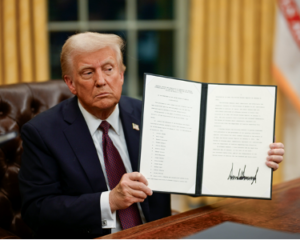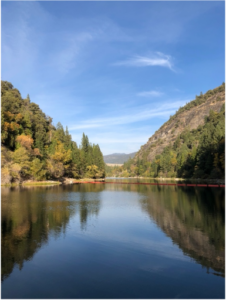HOW WILL NEW ADMINISTRATION POLICIES AT THE NATIONAL LEVEL TRICKLE DOWN TO AFFECT WATER, FOREST, AND WILDLIFE ISSUES IN OUR LOCAL REGION?
CSERC strictly adheres to avoidance of political support for any candidate, any legislation, any Congressional budget action, or anything that qualifies as political advocacy. As a 501(c)(3) non-profit, our Center is politically neutral.
But our staff fully embraces our responsibility to identify factual threats to the environment as they arise, whether the threats are posed by pollution, extreme wildfires, Democrats, Republicans, independents, Libertarians, or others.
We have an obligation to point out actions, policies, or statements made by those in powerful positions who have the potential to cause immediate and lasting harm to water resources, air quality, at-risk wildlife, forests, and wild places.
Already this month President Trump has signed numerous Executive Orders on behalf of the new Administration in Washington, DC. Looking only at those Orders that affect the natural environment, it is clear that a number of critical threats to nature are dramatically unfolding.
THREATENED AND ENDANGERED SPECIES
One key Executive Order is based on the claim there is somehow an “energy emergency,” (even though oil and gas production has been at very high levels in our country over recent years, and despite gas prices being lower currently than in past years). As part of his Executive Order, the President is resurrecting a special national level committee called the Endangered Species Act Committee. This committee in the past was called the “God Squad” because it is empowered to judge whether an endangered species will be protected or whether the Committee for economic reasons will approve a federal project or action that may cause the species to potentially go extinct. Some of those being appointed to the Committee to make those critical endangered species decisions appear to represent pro-oil and gas or other industry interests, not wildlife.
In his “National Energy Emergency” Order, the President also directed the halt of federal funding for already approved electric vehicle charging stations and for extensive planned wind power projects. Instead, the Order emphasizes speedy implementation of a wide range of actions tied to the new administration’s strong support for fossil fuels.
The Executive Order directs the opening-up of more federal lands to oil and gas drilling. It aims to eliminate federal support for electric vehicles and to reverse previous administration policies that promoted energy efficiency lightbulbs, dishwashers, toilets, water heaters, etc. The Order prohibits any and all “burdensome” regulations that may affect oil and gas, coal, hydropower, biofuels, and nuclear power – completely ignoring the benefits of clean alternative energy sources such as solar, wind, and conservation policies that reduce energy consumption.
The Executive Order also openly targets previous federal policies and orders that were intended to reduce the impacts of Climate Change. A long list of new Administration policies are now mandated that would reduce protections for federal lands and for the environment affected by mining, energy exploration, and resource processing.
WATER MEASURES IN CALIFORNIA
In a separate action, the President signed a new Executive Order that misleadingly blames California water management policies for the disastrous Los Angeles wildfires. The fires, in fact, were a direct result of extreme Santa Ana winds along with months of bone-dry weather conditions prior to the fires that resulted in unstoppable wind-blown walls of flame that engulfed communities. While numerous factors resulted in fire hydrants in some areas being overtaxed by firefighting demands, most Southern California reservoirs had high, plentiful levels of available water at the time of the fires, and State water policies played no factor in the windblown fires.
Under the new Executive Order, key Trump appointees are mandated to report to him on various actions to maximize water deliveries from the Central Valley Project and from federal water management to deliver more water to Southern California. What is not acknowledged in the Order is that most of that additional diverted water would primarily boost profits for huge agricultural operations that already get massive amounts of low-cost deliveries of federal water. His public statements also directly blamed the Southern California fires on the Delta smelt and on supposedly “extreme environmentalists” trying to protect the endangered fish. In truth, protective measures for that at-risk fish in recent years have not blocked high amounts of water from consistently flowing to Southern California to fill reservoirs and to supply agriculture.
AND FAR MORE...
Adding to the many Orders that he has now signed, the President has mandated a halt in most expenditures of discretionary federal funds (immediately stopping many federal programs that affect the environment). He’s mandated a hiring freeze for federal agencies, and he’s committed America to withdrawing from the Paris Climate Agreement (which was the international agreement for countries to collaborate on a global level approach to slow global climate change).
Many of these significant actions affecting the environment will assuredly ripple down from the national level to directly affect local national forests and regional at-risk wildlife species, as well as local federal agency decisions for everything from river management to whether to protect air quality.
For our Center, we will continue to focus on ways to work with all political interests to strive to protect forests, watersheds, and wildlife through our engagement in collaborative-based stakeholder groups.
We also believe it is important for citizens of all parties and of all points of view to stand up to criticize national level decisions and actions that may significantly harm the environment or that will block critically needed strategies to reduce the negative effects of climate change that affects our entire planet.
Being informed and finding effective ways to speak out against harmful policies is a basic responsibility for all of us who are part of the complex web of life on planet Earth. CSERC aims to continue to advocate pro-active, positive remedies to resolve resource issues. We also will continue to work to bolster the capacity of understaffed federal agencies such as the Park Service, BLM, and the Forest Service.
If the Administration’s goal is to escalate economic benefits for resource extractors, big oil and gas, and other “deep pockets” corporations or billionaire interests, there are still many environmentally sensitive policies and projects that can produce profitable, win-win outcomes – if those in power are willing to look for those balanced outcomes.




